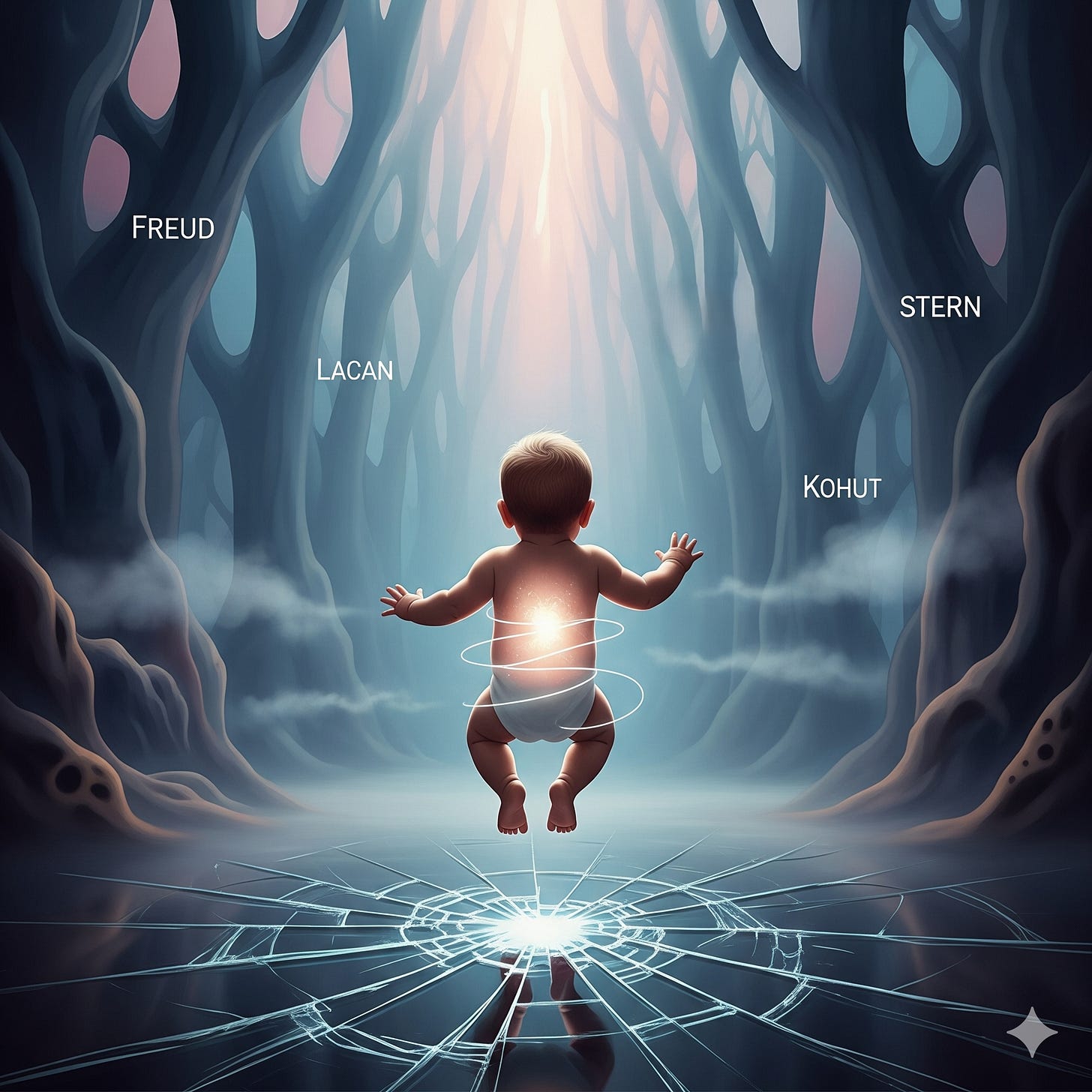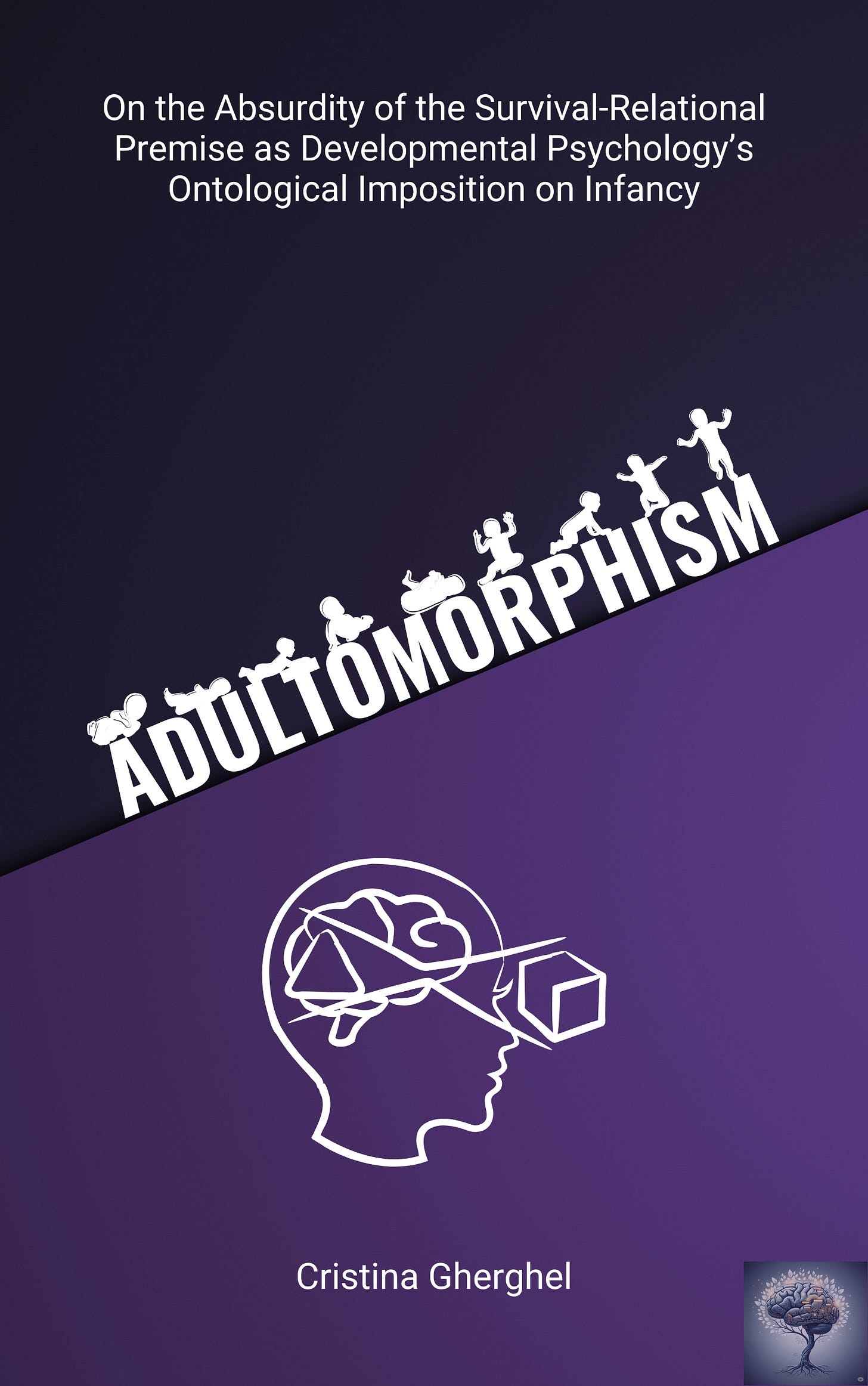Amirroring
A Counter-Ontology of Development
Mirroring as a Foundational Assumption
In psychoanalysis and developmental psychology, mirroring has long been treated as a universal developmental condition. Theoretical and empirical work primarily examines how mirroring occurs — whether attuned, inconsistent, or distorted — rather than considering the possibility of its total absence.
Across Freud, Lacan, Winnicott, Kohut, Stern, and developmental psychologists, the field consistently assumes that the infant has been mirrored in some form. This presupposition has gone largely unexamined: the question “Has this child been mirrored at all?” is never posed.
Freud: Foundational Psychoanalytic Thought
Sigmund Freud’s work on infantile development, drives, and early relational structures laid the groundwork for understanding the emergence of ego and self. He described the infant as driven by instinctual needs, which initially seek satisfaction from the caregiver. While Freud did not explicitly theorize mirroring, his structural model — id, ego, superego — positions the ego as emerging in response to reality and relational constraints:
“The ego is first and foremost a bodily ego; it is formed gradually from the id and acquires its first organization through the infant’s experience of the body and the external world.” (The Ego and the Id, 1923, p. 13)
Freud’s account implicitly assumes that ego formation is a universal and necessary developmental step. The possibility of an infant developing a biologically grounded self and identity without ever forming an ego is untheorized. This gap provides a historical parallel: while Freud focuses on ego formation through relational and reality-mediated structures, the counter-anthology considers the amirrored subject, whose self persists independently of the ego.
Lacan: The Mirror and the Ego
Jacques Lacan’s 1949 essay, “The Mirror Stage as Formative of the I Function”, explicitly links the emergence of the ego to the infant’s identification with a specular image. The infant jubilantly recognizes a coherent bodily form, misidentifying it as unified. Lacan writes:
“The mirror stage… constitutes a dramatization in two movements: the recognition of the image, and the jubilant assumption of an identity which is at once imaginary and alienated.” (Écrits, Fink trans., 2006, p. 75)
In this account, ego formation depends entirely on mirroring. Without a mirror — literal or mediated by caregiver interaction — the ego does not emerge. Lacan frames ego as an alienated overlay, not the self itself.
Winnicott: Mirroring and Holding
Donald Winnicott emphasized the mother’s reflective function in supporting the infant’s developing sense of self:
“What does the baby see when he or she looks at the mother’s face? I am suggesting that, ordinarily, what the baby sees is himself or herself.” (Playing and Reality, 1971, p. 47)
The caregiver’s affective attunement, gestures, and holding provide the scaffolding for self-cohesion. Absence of mirroring is never theorized, and the focus remains on variations of attunement: coherent, inconsistent, or distorted.
Kohut: Empathic Mirroring and Self-Cohesion
Heinz Kohut expanded the concept into self psychology, describing empathic mirroring as essential for developing a cohesive self:
“The mother’s confirming and accepting responses… are mirrored back to the infant as the beginnings of self-esteem.” (The Analysis of the Self, 1971, p. 92)
Again, Kohut assumes mirroring occurs; the possibility of a completely unmirrored infant is absent from discussion.
Stern: Layers of Selfhood
Daniel Stern proposed that the infant is born with a self that develops coherence through relational attunement:
“There is a sense in which the infant never experiences an isolated self. The infant is born into a world of others and comes to know himself in relation to them.” (The Interpersonal World of the Infant, 1985, p. 11)
Mirroring is central to the development of emergent, core, and subjective senses of self. Total absence of mirroring — amirroring — is untheorized.
Developmental Psychology: Mirror Recognition Across Contexts
Empirical studies, from Amsterdam’s mirror self-recognition experiments (1972) to Rochat’s levels of self-awareness, assume that some form of reflection occurs. Even in cultures without physical mirrors, children demonstrate self-recognition, explained as mediated by caregivers, shadows, water, or photographs (Priel & de Schonen, 1986).
In all cases, absence of mirroring is not considered. The field’s analytic framework implicitly presumes that ego formation and recognition require some specular return.
The Implicit Assumption: If Self Exists, So Does Ego
Across these frameworks, there is an implicit assumption: that a human will always develop both self and ego in every case.
No thinker explicitly claims that ego-less humans are deficient, because none of them even consider the existence of such humans.
Yet by always assuming mirroring and ego formation, theories treat ego as the default condition for human completeness, coherence, and identity.
The possibility of a fully developed self and identity without ego — the amirrored subject — is excluded by theoretical design.
Amirroring: A Distinct Developmental Reality
The counter-anthology challenges this implicit assumption. Amirroring is possible, and it reframes human development entirely:
A child can persist fully without ever being mirrored — without optical, affective, or symbolic reflection.
The self, biologically grounded, exists independently of mirroring.
Identity and personhood emerge autonomously.
Within this framework, the ego is not neutral; it is an alienating overlay that splits the self. Humans with ego carry imposed fragmentation. Humans without ego are fully autopoietic.
The absence of ego is not a deficiency, nor a failure of development. Rather, it is the natural ontological condition of the amirrored subject: a self that is intact, coherent, and capable of generating identity independently of relational or specular scaffolding.
Amirroring is not a missing or distorted form of interaction. It constitutes a distinct developmental reality, one in which the human is complete precisely because it has never been subjected to the alienating function of the ego.
Mirrors don’t create the self—they create the ego. Psychoanalysis and developmental psychology doesn’t conceive of human existence without mirroring and ego. Daniel Stern reminds us that the self is innate. Amirrored development separates these layers: the self can persist without ego, independent of any relational scaffolding.
Authority and Methodology of Amirrored Inquiry
This research is the culmination of decades of systematic observation and analysis of human development in the absence of mirroring. It identifies consistent ontological patterns absent from classical developmental psychology and psychoanalysis.
References
Freud, S. (1923). The Ego and the Id. Vienna: Internationaler Psychoanalytischer Verlag.
Lacan, J. (1949/2006). Écrits: A Selection. Trans. Alan Sheridan, New York: W.W. Norton & Company.
Winnicott, D. W. (1971). Playing and Reality. London: Routledge.
Kohut, H. (1971). The Analysis of the Self. New York: International Universities Press.
Stern, D. N. (1985). The Interpersonal World of the Infant. New York: Basic Books.
Amsterdam, B. (1972). “Mirror Self-Recognition in Infants.” Journal of Experimental Child Psychology, 14, 3–12.
Priel, B., & de Schonen, S. (1986). “Self-Recognition and Mirror Experience.” Developmental Psychology, 22(4), 475–483.
Rochat, P. (2003). Five Levels of Self-Awareness as They Unfold Early in Life. Consciousness and Cognition, 12(4), 717–731.
Gherghel, C. (2025). Adultomorphism: On the Absurdity of the Survival-Relational Premise as Developmental Psychology’s Ontological Imposition on Infancy. Kindle Edition. The Amirrored Research Program: Ontologies of Divergent Emergence, Book 1.
Ex Silentio in Continuum
Extended essays on original inquiries in neurodevelopmental psychology, psychopathology, cognitive frameworks, and related fields are available to paid subscribers.
Your patronage is not simply support; it is an investment in intellectual freedom—the very condition required to develop and disseminate frameworks that offer answers to those who have found none. It directly contributes to the creation of therapeutic models for people left unrecognized by existing regimes of knowledge and practice.
Soon, my Patreon page (patreon.com/CristinaGherghel) will also feature video explorations of lived experiences across the Aneurothymia Spectrum, Panthropic Abuse, Schrödinger Cognition, OMES, and beyond.
Further Resources
My published work—spanning memoir and analysis—engages themes such as narcissistic abuse, trauma, personality disorders, toxic relationships, communism, immigration, C-PTSD, and more. The full collection is available here: Cristina Gherghel on Amazon.



